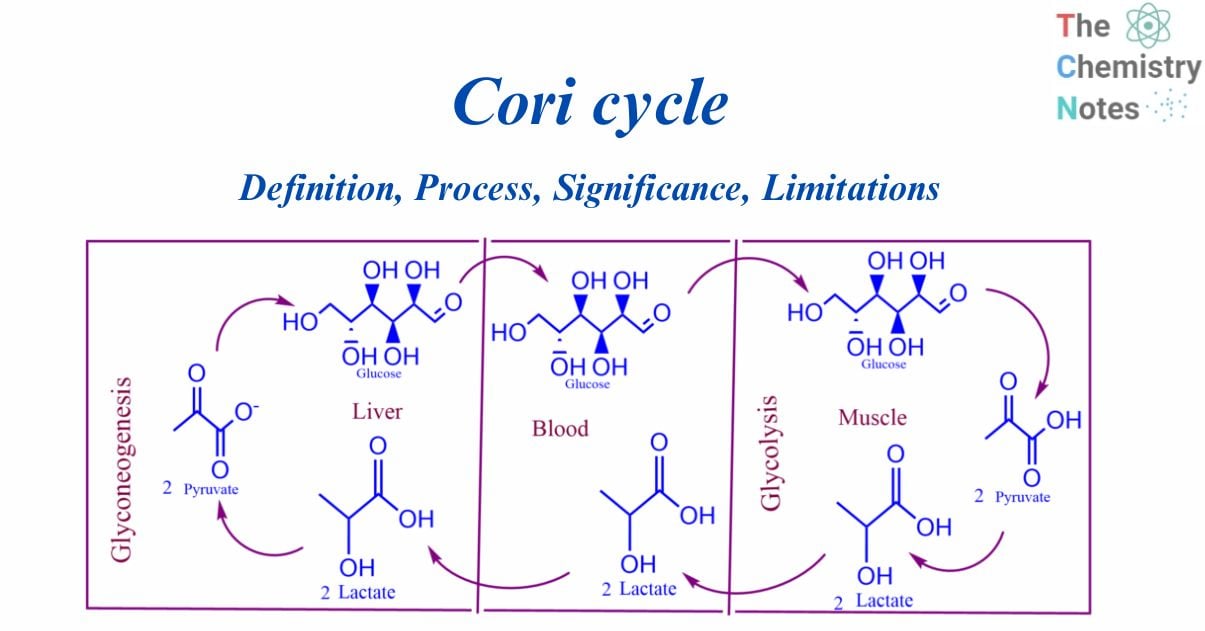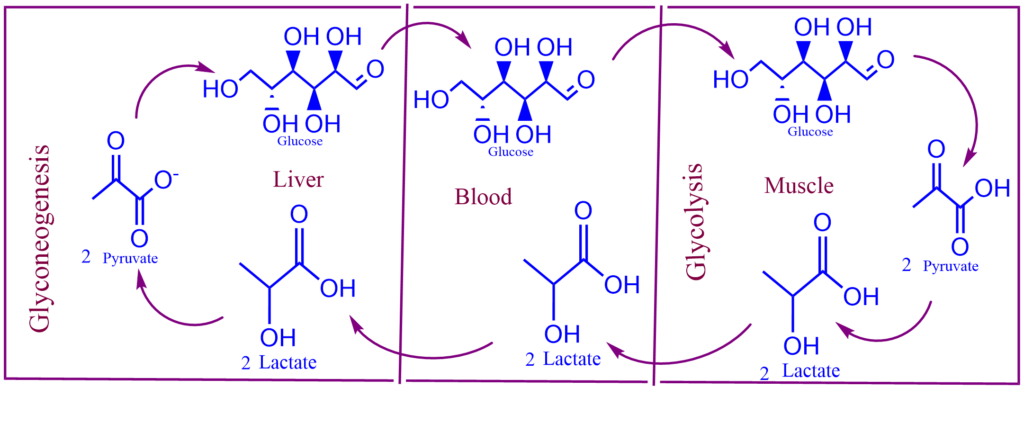
The Cori cycle is also known as the lactic acid cycle. It is named after two Carl Ferdinand Cori and Gerty Cori in 1929. The Cori cycle (also known as the lactic acid cycle) is a metabolic mechanism that takes place in the liver and muscles. It is the process through which lactic acid produced by anaerobic glycolysis within muscle cells is transported to the liver and converted into glucose. It can then be used as energy by the muscles once more.
- Aerobic condition

- Anaerobic condition (During excessive exercise)

Due to the absence of O2, the terminal electron acceptor, the TCA cycle will not take place in anaerobic conditions after the synthesis of pyruvate from glucose. Muscle cells rely on anaerobic metabolism to generate energy when there is a lack of oxygen. As a result, lactic acid is produced, which can collect in the muscles and cause fatigue. Under anaerobic conditions, the Cori cycle avoids lactic acidosis (excessive lactate buildup) in muscle. This cycle is particularly necessary for the generation of energy molecules (ATP) during muscle exercise, because muscles lose energy due to a lack of glucose. Thus, the Cori cycle promotes appropriate muscle activity by supplying needed energy in the form of glucose.
In this pathway, lactate produced by anaerobic glycolysis is released into the blood by exercising skeletal muscle and the cells that lack a nucleus i.e. RBC. The lactate produced is taken up by the liver and oxidized to pyruvate which is converted to glucose and released into circulation.
Interesting Science Videos
What is the Cori cycle?
The Cori cycle, commonly known as the Lactic Acid Cycle, is a metabolic process that includes two major metabolic processes: glycolysis and gluconeogenesis. Our muscles run out of oxygen during intense muscle exertion or activity and consequently suffer anaerobic glycolysis. Anaerobic glycolysis converts one glucose into two net ATP and two pyruvate. These two pyruvates from anaerobic glycolysis are likewise converted by lactate dehydrogenase into two lactates or two lactic acids during anaerobic fermentation to regenerate NAD+ carriers.
Process of Cori cycle
During strenuous exercise, the oxygen supply becomes insufficient, and an excess of lactic acid builds in muscle fibers and diffuses into the bloodstream.
The reason for this is that the synthesis of NADH by glycolysis surpasses the respiratory chain’s ability to oxidize it back to NAD+. Lactate dehydrogenase converts the pyruvate produced by glycolysis in muscle to lactate.
The liver absorbs the majority of the blood lactate and converts it to glucose via gluconeogenesis. This glucose is reintroduced into the bloodstream and reaches skeletal muscle and the brain. Glycogen is produced in the muscle through glycogenesis, replenishing the muscle’s depleted glycogen supply. The liver and muscles work together to create a larger cycle in which lactic acid flows. This is the cycle that involves:
muscle glycogen → muscle lactate → blood lactate → liver glucose ↔ blood glucose → muscle glycogen.

Process involved
- ATP required during muscular activities is provided by the stored glycogen in muscle by the breakdown of glycogen via glycogenolysis
- during glycogenolysis glucose is released in the form of glucose 1-phosphate (G1P). The G1P is converted to G6P by phosphoglucomutase. G6P is readily fed into glycolysis, (or can go into the pentose phosphate pathway. if G6P concentration is high) a process that provides ATP to the muscle cells as an energy source
- During the abundance of oxygen supply, the pyruvate formed as the end product of glycolysis fed into the Krebs cycle for the production of ATP
- If the oxygen supply is insufficient as during intense muscular activities energy must be released via anaerobic metabolism. So lactic acid fermentation takes place thus pyruvate is converted to lactate by the enzyme lactate dehydrogenase
- The lactate produced in muscle is released into circulation and enters the liver. In the liver, gluconeogenesis occurs thus producing glucose which is then fed into muscle via the bloodstream which can undergo further glycolysis in muscle. If muscle activity has stopped, the glucose is used to replenish the supplies of glycogen through glycogenesis which is stored in muscle.

Significance of the Cori cycle
- It is responsible for immediate ATP production as an energy source during muscle exertion(depleted oxygen state)
- It prevents lactic acidosis during anaerobic conditions by moving out the formed lactic acid from muscle to liver
- The lactic acid formed in muscle is an important substrate for gluconeogenesis. It contributes to glucose production during fasting
- Lactic acidosis due to the drug metformin in kidney failure patients is due to the inhibition of hepatic gluconeogenesis of the Cori cycle. In normal patients, the excess lactate is cleared by the kidneys, but in patients with kidney failure kidneys cannot handle the excess acid.
Regulation of the Cori cycle
Cori disease, also known as glycogen storage disorder type III, is a rare inherited ailment that prevents the body from converting glycogen to glucose. This results in glycogen buildup in the liver and muscles, resulting in symptoms such as muscular weakness, enlarged liver, and low blood sugar levels. Some regulatory factors involve:
- Hormones such as insulin, glucagon, and adrenaline can alter the Cori cycle by influencing glucose uptake and release in the liver and muscles. Insulin stimulates glucose absorption by muscle cells, whereas glucagon and adrenaline cause the liver to release glucose.
- A lack of oxygen in muscle cells initiates the Cori cycle, which results in anaerobic metabolism and the generation of lactic acid. When there is sufficient oxygen, aerobic metabolism takes control, producing more ATP and decreasing the need for the Cori cycle.
Cori cycle disorders
Cori disease
Cori disease, also known as glycogen storage disorder type III, is a rare inherited ailment that prevents the body from converting glycogen to glucose. This results in glycogen buildup in the liver and muscles, resulting in symptoms such as muscular weakness, enlarged liver, and low blood sugar levels.
Lactic acidosis
Lactic acidosis is a condition in which the body accumulates lactic acid. It can be caused by a variety of factors, including decreased oxygen transport, mitochondrial dysfunction, or Cori cycle irregularities.
Exercise-induced hypoglycemia
It is a condition in which blood sugar levels drop substantially after physical activity. It is thought to be caused by a combination of increased muscle glucose absorption and decreased liver glucose production.
Limitation of Cori cycle
Using the Cori cycle, the human body can convert metabolic by-products into a source of energy for the muscles. However, it cannot continue to do so infinitely.
- Similar to many other natural cycles, the Cori cycle isn’t a completely closed loop. In the muscles, glycolysis results in the production of two units of ATP. However, the liver uses up six units of ATP to carry out the process of gluconeogenesis. The Cori cycle also requires the initial introduction of oxygen, without which it cannot begin. As such, eventually, the muscles are bound to require a new supply of glucose as well as oxygen.
- If physical activity is excessively intense, the energy required by the muscles will surpass the capacity of the Cori cycle to replenish glucose from lactate. This will result in lactic acidosis, which is the accumulation of excess lactic acid in the system. Lactic acidosis lowers the pH of the blood, which can cause tissue damage. It also causes symptoms related to panic, such as hyperventilation, abdominal cramps, vomiting, and so on, all of which are the body’s natural defense systems aimed to slow down intense activity and prevent permanent harm.
References
- https://www.tuscany-diet.net/2016/12/18/cori-cycle/
- https://biologywise.com/brief-explanation-of-cori-cycle.
- http://chemistry.elmhurst.edu/vchembook/615coricycle.html.
- https://www.davuniversity.org/images/files/study-material/BCH5156-1.pdf.
- Ferrier D. R. & Harvey R. A. (2014). Lippincott’s illustrated reviews: biochemistry (6th ed.). Wolters Kluwer Health : Lippincott Williams & Wilkins.
